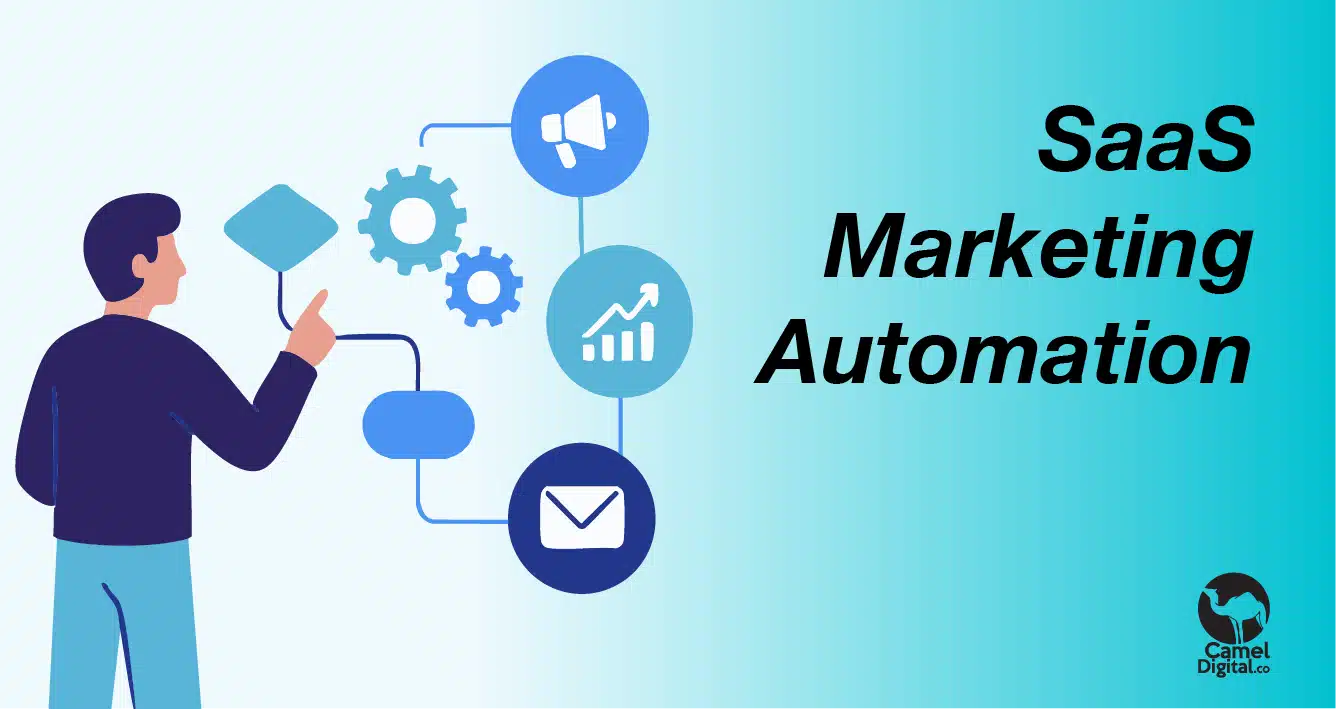Six years ago, SaaS teams spent hours pulling reports, building lists manually, and tweaking campaigns line by line. Today, automation does the heavy lifting of freeing marketers to focus on strategy, creative testing, and scaling results with confidence.
SaaS marketing demands this level of precision. Trials, demos, onboarding, renewals, and upsells all move too quickly for manual workflows to keep up.
In this blog, we’ll share everything we’ve learned and tested for more than 6 years:
- How to redesign SaaS marketing workflows with automation
- The tested use cases for 2025
- How to integrate SaaS marketing automation smartly
What is SaaS Marketing Automation?
The classic definition you’ll see in most marketing blogs is simple: marketing automation is the use of software to streamline, automate, and measure marketing tasks and workflows.
That definition works if you’re selling shoes or coffee subscriptions, but it misses the unique reality of SaaS.
Our buyers don’t just hit “buy now.” They move through free trials, product demos, onboarding, expansions, renewals, and referrals. Each stage has different triggers, data points, and messaging requirements.
In SaaS, marketing automation means building systems that connect data across channels and customer journeys. It’s more than drip emails, it’s syncing ad audiences with trial data, personalizing messages based on in-app behavior, and prioritizing leads automatically based on usage signals. Done right, automation is less about saving time (though it does that) and more about making SaaS growth predictable.
In practice, this means your retargeting doesn’t waste money on inactive users, your sales team only gets qualified trial leads, and your reporting updates itself in real time.
That’s SaaS marketing automation: a framework that makes every dollar of ad spend and every hour of work compound into measurable ROI.
Why Marketing Automation is a Game-Changer for SaaS
Marketing automation is about building smarter systems that guide users through the SaaS funnel with less friction.
Lead Nurturing That Converts More Signups Into Paying Users
Most SaaS leads today come from digital channels: free trials, Google Ads for SaaS, lead magnets, cold outreach, email, and website marketing.
The big advantage is that every one of these interactions happens online, which means we can track them, respond instantly, and automate the next step with almost zero delay.
Instead of waiting for a sales call or manual follow-up, automation allows us to react to real behavior in real time. That’s what makes SaaS different: every click, signup, or in-app action creates data we can use to move leads closer to becoming paying users.
Here’s a simple example of marketing automation for SaaS we used for one of our clients selling a CRM tool:
- Step 1: User signs up for the trial.
- Step 2: If no contact is created in the first hours, an automated email sends a 2-minute “getting started” video.
- Step 3: Once a contact is added, the system triggers a tip on integrating email.
- Step 4: After a few meaningful actions, the user enters a retargeting audience with upgrade offers.
Why it works: 75% of trial users abandon if onboarding feels complicated or support is delayed. Automation removes that friction by delivering value at the right moment.
Personalization That Scales With Your User Base
As your SaaS user base grows, every signup behaves differently. Some users explore the product in the first hour, while others click around once and then disappear. That’s where behavioral triggers (reacting to what a user actually does) and segmentation (grouping users by those behaviors) become essential for communication that feels relevant instead of random.
Take one of our PLG SaaS clients as an example.
- Step 1: A new user creates their first dashboard
- Step 2: Within minutes, an email arrives showing how to add a second data source.
- Step 3: If they follow through, the next step introduces advanced filtering. If they stall out after the first action, we send a short video walking them through the next move.
- Step 4: If they completely pause, a re-engagement nudge goes out with a clear, single-click path back into the product.
We love these SaaS marketing automation tools because data shows behavior-based emails deliver 120% higher open rates, 110% higher click rates, and over 400% better conversions than generic campaigns. In practice, that means users stick around longer because they’re being guided feature by feature, instead of being left to figure things out alone.
At Camel Digital, we’ve learned that templates don’t scale but segmentation strategy does. Planning early who gets what message and when keeps communication helpful, natural, and aligned with how real users adopt your product.
Want our help with that?
Campaign Efficiency Without Manual Guesswork
In SaaS, campaign execution has always been resource-heavy: endless setup, long waits for results, and constant uncertainty about what to test next.
Automation changes that equation. Instead of manually creating every variation and waiting weeks for insights, automation allows teams to launch, measure, and optimize multiple campaigns in parallel. Execution time drops, testing volume rises, and marketers get faster learning cycles with more reliable outcomes.
Consider a content-heavy SaaS company. Automation reshaped their marketing stack in three practical ways:
- Content republishing: high-performing blog posts were automatically reintroduced on a set schedule, each time refreshed with updated CTAs.
- Follow-up CTAs: once a visitor downloaded an ebook, a triggered sequence immediately offered a webinar invite or a trial sign-up.
- Triggered remarketing: users who consumed multiple posts were automatically funneled into remarketing campaigns, with ad creatives tied directly to the topics they had shown interest in.
This type of setup eliminates repetitive manual work. No one needs to reschedule posts, rebuild audiences, or track engagement by hand. More importantly, the increased testing capacity reveals high-performing combinations in weeks instead of months.
That’s the essence of marketing automation for SaaS companies: not just efficiency in execution, but the ability to scale structured experiments that consistently surface what works best.
Driving Revenue Through the Entire Lifecycle
In SaaS, the customer journey doesn’t end at signup. That’s where the real revenue story begins. Upsells, renewals, and usage-based expansions often drive a larger share of growth than new acquisitions, but managing them manually is nearly impossible at scale.
Automation gives SaaS teams the ability to monitor usage signals and act before opportunities slip away.
Take a B2B SaaS company as an example: when product usage falls below a healthy threshold, automation triggers two parallel responses.
- First, a CSM alert ensures the customer success team gets visibility to step in personally.
- Second, a re-engagement campaign launches automatically – emails or in-app prompts showing value-driving features that the account hasn’t adopted yet.
On the flip side, when usage spikes or more seats are being added, automation can surface upsell offers or usage-based expansion paths right inside the product. Add loyalty campaigns on top of that, and accounts most likely to renew or refer are segmented for rewards and advocacy at just the right time.
This is where automation proves its direct link to SaaS ROI. By reducing churn risk, systematizing upsells, and creating predictable renewal cycles, SaaS companies turn the customer lifecycle into a revenue engine instead of a renewal gamble.
Where Marketing Automation Fits in the SaaS Funnel
In the SaaS marketing funnel, the key challenge is the time gap between initial interest and paid adoption.
Prospects may engage with ads, content, or trials, but moving them all the way to becoming paying users often takes weeks of consistent touchpoints.
Delays give competitors an opening. Automation fills the gap at each funnel stage so no lead is wasted and every follow-up matches real behavior.
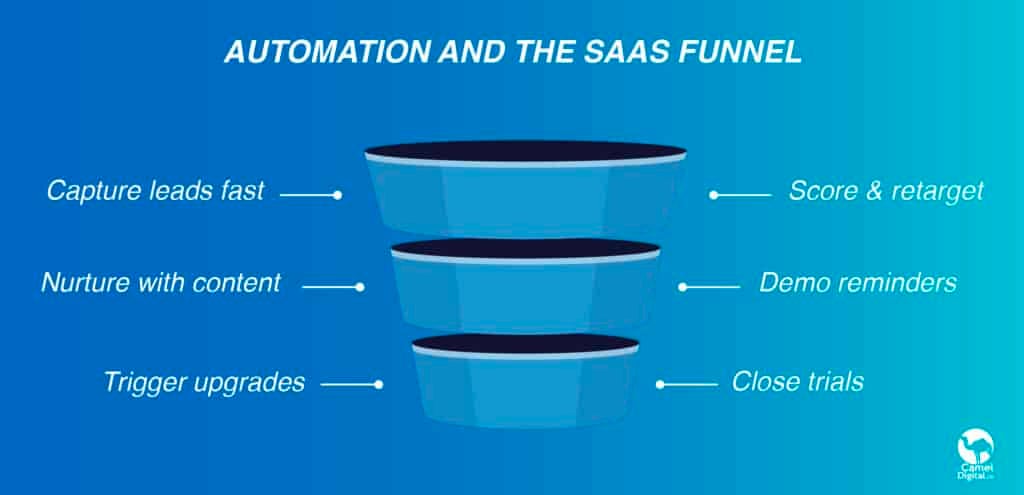
TOFU: Capture and Qualify Before Competitors Do
At the top of the funnel, SaaS companies deal with high lead volumes from ads, blog posts, lead magnets, and social campaigns. Without automation, most of these leads would either be ignored or followed up on too late. Automated lead scoring, retargeting, and CTA-triggered emails allow teams to capture early interest and push it into structured next steps instead of relying on manual sorting.
Automation also ensures TOFU stays efficient. For example, once a visitor downloads a resource, systems can immediately assign a score, deliver a relevant follow-up, and place them in the correct retargeting pool. This level of instant reaction means marketers can extract more value from paid campaigns and organic traffic without manually chasing every click.
MOFU: Keep Consistent Engagement Until the Demo
The middle of the funnel is where potential buyers are evaluating options, asking questions, and testing features. Automation helps by keeping communication consistent and timely, without depending on manual reminders.
Drip campaigns are a proven method here, sending short, useful content such as feature spotlights, integration guides, or case studies over a structured timeline. This keeps prospects moving forward instead of leaving them to figure things out on their own.
Another MOFU strength is demo management. Automated reminders sent a day before, an hour before, and even as calendar holds reduce no-shows and wasted sales resources. By combining education with reliable scheduling, automation ensures leads don’t stall halfway through the journey.
BOFU: Convert Trials Into Paying Accounts
At the bottom of the funnel, the most valuable signals come from in-product behavior. Automation enables teams to respond instantly when trial users hit critical usage milestones. For instance, once a user creates multiple projects or invites teammates, the system can trigger targeted upgrade offers inside the app and follow up with personalized pricing emails.
The same approach applies to pricing page visitors. If someone spends time reviewing plans but doesn’t convert, automation can immediately deliver case studies or ROI calculators linked to the exact tier they viewed, while also notifying sales teams for personalized outreach.
6 Ways Automation Supports SaaS Growth
The biggest problem of SaaS lead nurturing is simple: people show interest but don’t use the product.
Yes, they might request a demo, even buy a starter plan, or sign up for a trial, but then they don’t put enough time and attention into exploring the product and its features. That’s the number one issue. If people don’t use the product, they don’t see value, and sooner or later, they leave.
Automation helps change this.
B2B SaaS email marketing automation, in-app prompts, and usage-based alerts remind users to come back, guide them through setup, and show them what to try next.
Instead of waiting for someone from the team to notice inactivity, automation does the heavy lifting, keeping new users engaged before they drift away.
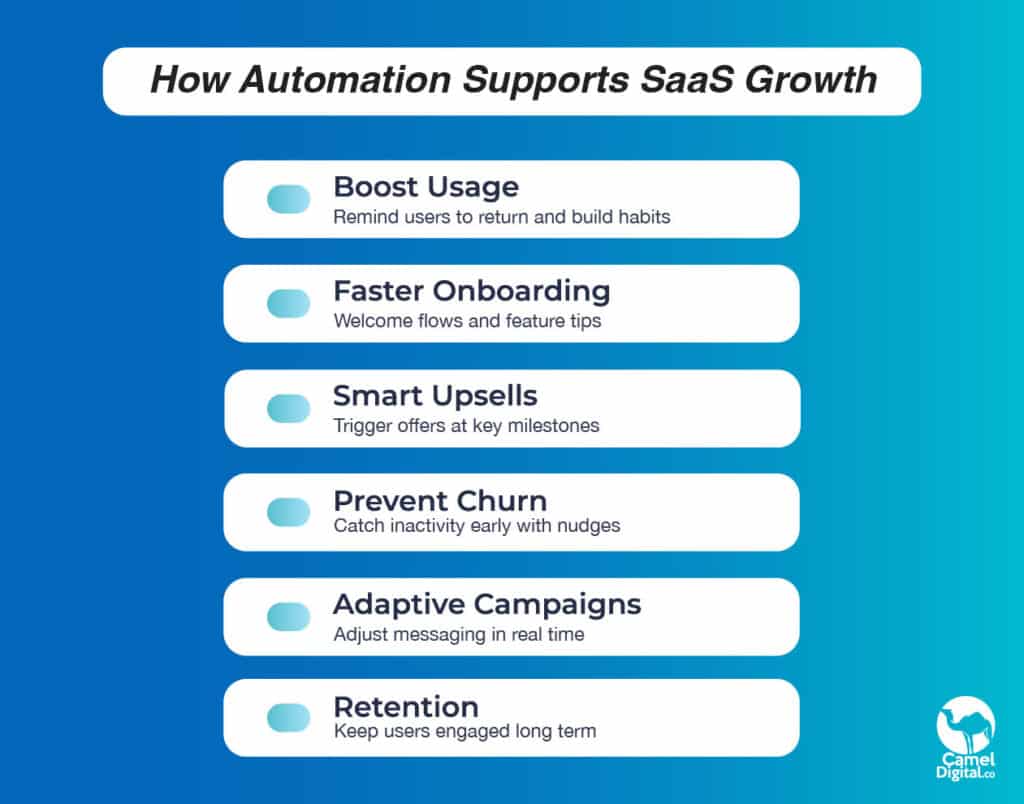
1. Driving Product Usage and Long-Term Engagement with Automation
One of the biggest SaaS challenges is low product usage after signup. Too many users register, click around once, and then disappear. That leads directly to churn. Automation fixes this with emails, in-app prompts, and usage-based alerts that guide users back and help them build habits with your product.
2. Faster Onboarding and Feature Discovery
When someone signs up, every day of silence increases the chance they will drop off. Automation solves this by delivering onboarding steps automatically: welcome emails, guided tours, and reminders for untouched features.
If a feature is not used in the first few days, the system can send a short explanation or a quick video showing why it matters. Done right, this shortens time to value and helps users stay engaged.
3. Lifecycle-Based Upselling
Upselling works best when it’s tied to what the user is actually doing. Email marketing automation for SaaS can monitor key milestones like when a team grows, when usage limits are close, or when advanced features get adopted.
At those points, the system can present relevant upgrade options – not generic pitches, but clear offers that match the user’s immediate needs. This makes upsells feel like natural next steps rather than sales pressure.
4. Churn Prevention Through Proactive Messaging
Churn often starts when users stop logging in or leave important setup steps incomplete. SaaS marketing automation can spot these patterns quickly. For example, no activity for a week, or a trial account that never connected to integrations. Once detected, the system sends targeted outreach: a tip to complete setup, a helpful tutorial, or an offer of support.
If inactivity continues, it can escalate to stronger re-engagement messages like discounts or feature highlights. Catching these signals early gives companies a chance to bring users back instead of losing them silently.
5. Campaigns That Adapt to User Behavior
Static campaigns treat every user the same, but automation allows campaigns to adjust in real time. A user who engages with a feature email is moved into deeper education flows, while someone who ignores it can be shifted into lighter-touch communication. This kind of adaptive approach keeps messages relevant, which improves user satisfaction and long-term product adoption.
6. Lower CAC and Higher LTV Through Automated Efficiency
Manual marketing processes eat up time and SaaS marketing budget because too many unqualified leads get the same attention as the right ones.
SaaS marketing automation tools solve this by automatically scoring leads, nurturing them with relevant information, and passing only high-quality prospects to sales. That lowers customer acquisition costs (CAC) because teams spend less chasing the wrong people.
On the other side, targeted engagement and upsell campaigns extend lifetime value (LTV). Put together, automation makes SaaS growth more efficient: less wasted spend, more value from each customer.
Best SaaS Marketing Automation Tools in 2025
In 2025, the best tools are the ones that simplify SaaS workflows, connect user data, and turn signups into paying customers with less manual effort. Here they are:
1. Encharge
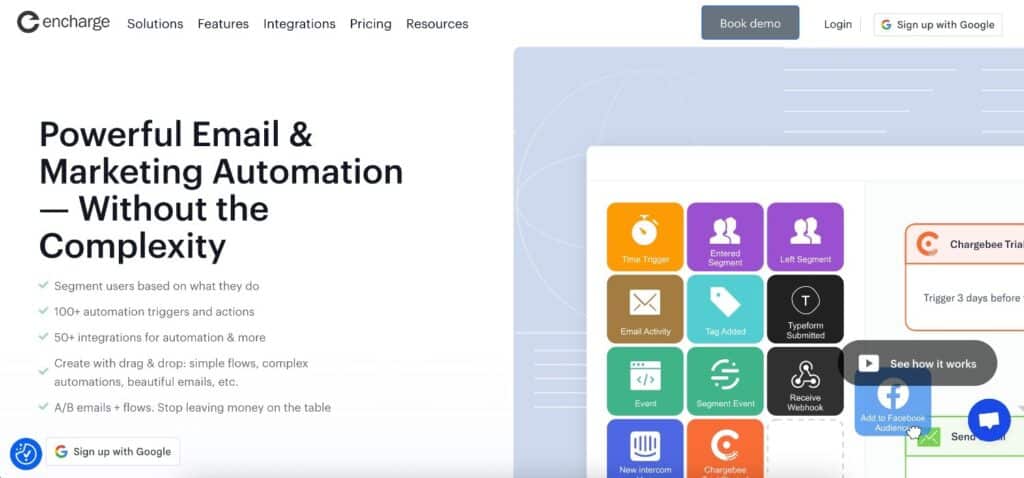
Encharge lets SaaS teams segment by live behavior and run automations with 100+ triggers across 50+ integrations. Build flows and emails via drag-and-drop, A/B test messages and journeys, and unify web, product, and marketing data.
This SaaS marketing automation tool allows you to see each user’s actions in real time and automate trial emails via Stripe/Chargebee/Paddle, including expirations.
2. Mailmodo
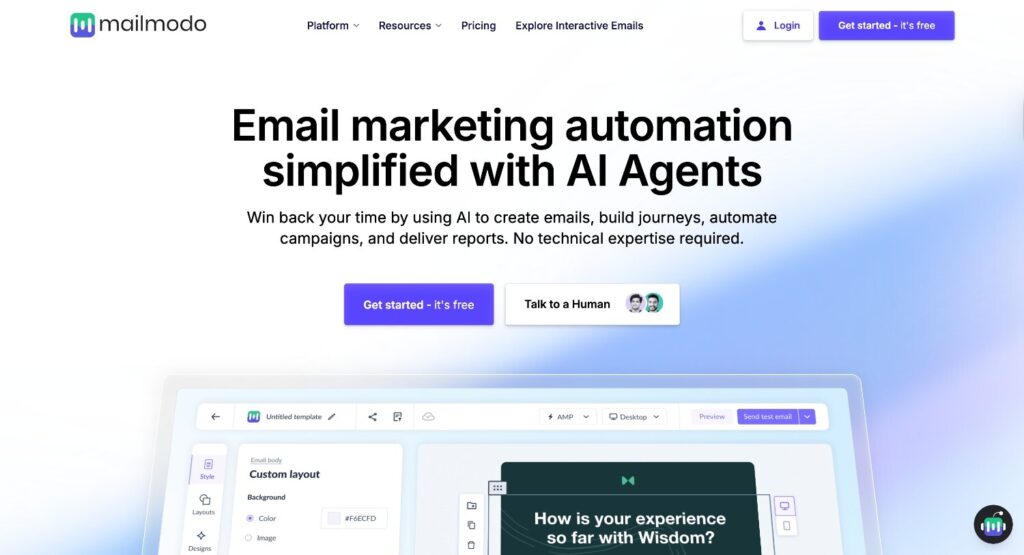
Mailmodo helps SaaS teams boost engagement with interactive emails, AI-driven campaigns, and ready-made customer journeys. You can choose from 30+ prebuilt flows with logic and templates, customize in minutes, and test even complex setups.
With Mailmodo, it’s easy to trigger campaigns by behavior or engagement, and manage dynamic segments that update automatically for precise targeting.
3. HubSpot
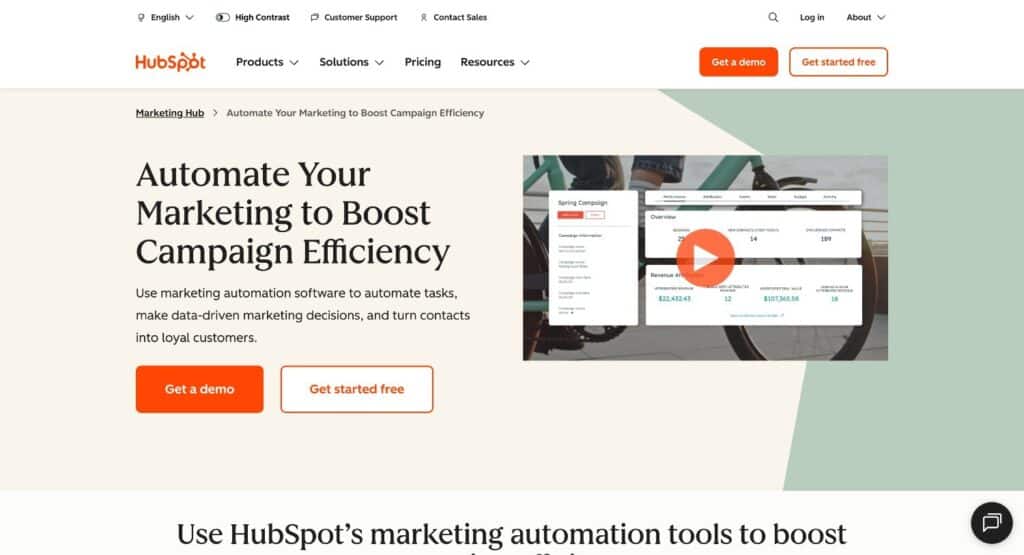
HubSpot’s Marketing Hub streamlines campaign management with automation across email, SMS, and retargeting, triggered by user interactions. It helps teams save time by eliminating repetitive work and reallocating resources to higher-impact projects.
Built-in analytics provide clear insights into performance, enabling marketers to optimize strategies and drive stronger lead generation with predictive data.
4. ActiveCampaign
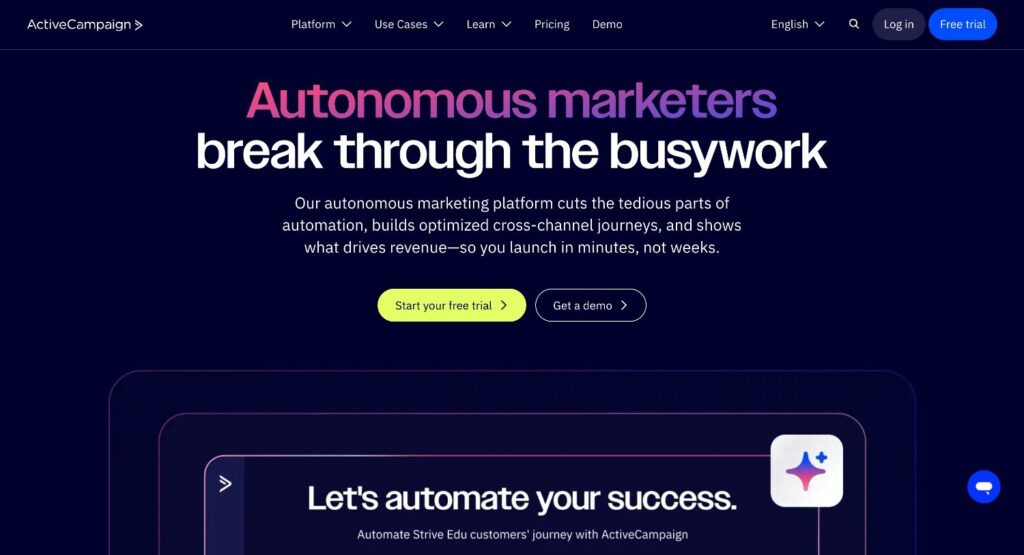
ActiveCampaign delivers advanced automation built for complex customer journeys while remaining flexible for simpler campaigns. Its editor combines AI-driven optimization with customizable workflows, split paths, and precise targeting.
From tailored emails to cross-channel messaging on WhatsApp, SMS, and social, it enables SaaS teams to engage audiences personally and consistently at scale.
5. Customer.io
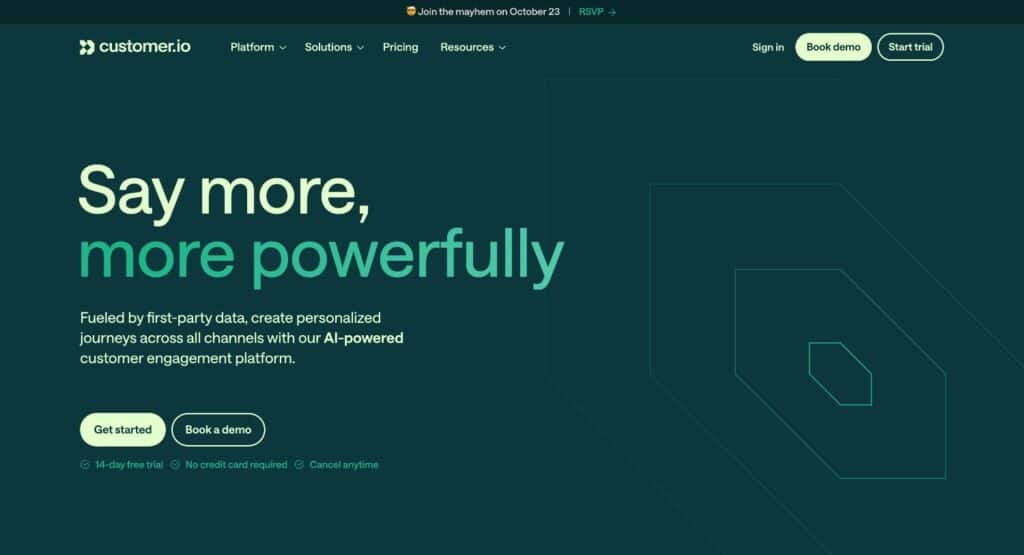
Customer.io uses first-party data to power personalized journeys across email, SMS, push, and more – all managed from one platform. With AI-driven insights, flexible automation, and deep integrations, it helps SaaS teams identify new opportunities, refine messaging, and strengthen relationships while proving impact with clear analytics and reporting.
6. Marketo
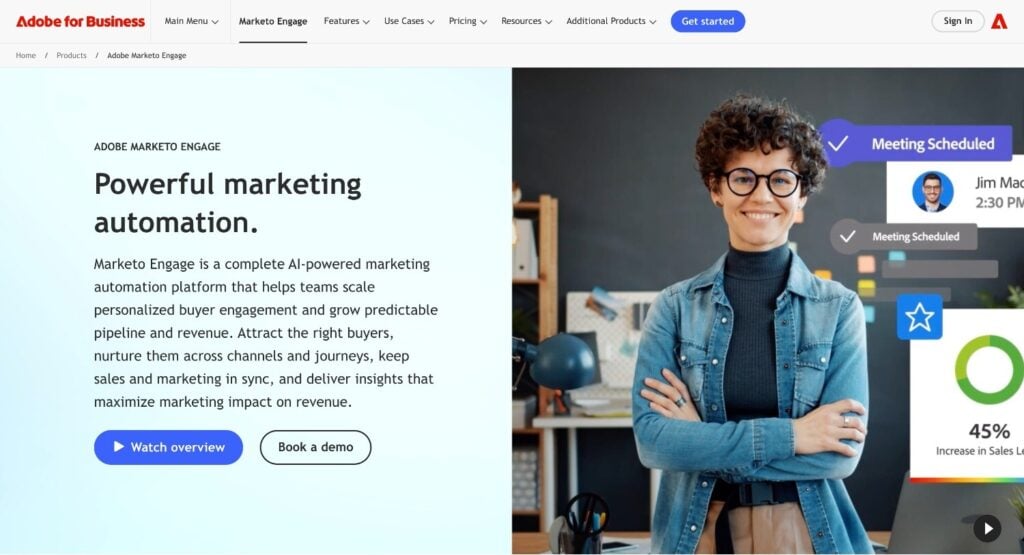
Marketo Engage is an AI-powered automation platform built to scale personalized engagement and generate predictable revenue. It serves as a central hub for planning, executing, and measuring omnichannel campaigns while keeping sales and marketing aligned.
With precise segmentation, enriched customer profiles, and CRM integrations, it delivers targeted messaging and revenue-focused insights.
7. Ortto (formerly Autopilot)
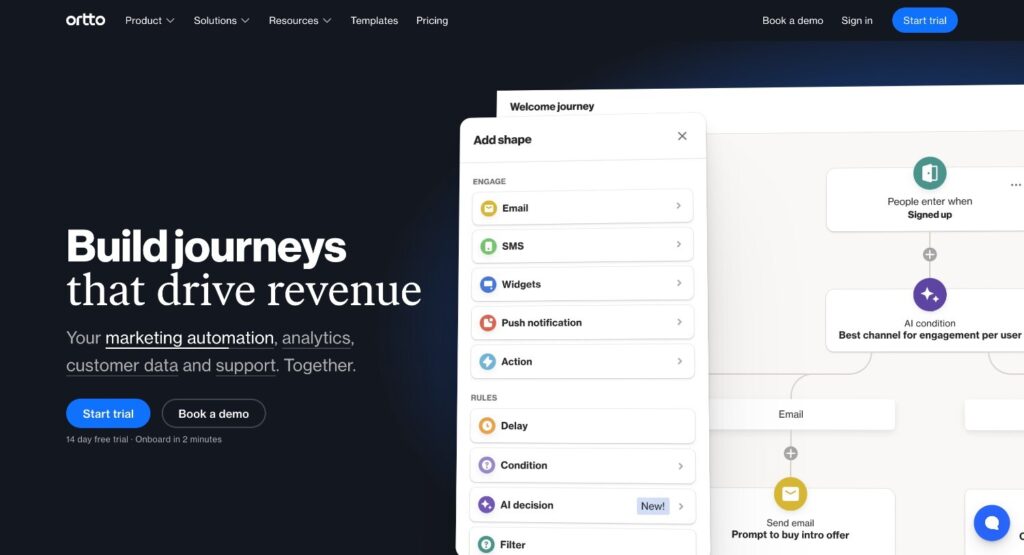
Ortto offers a visual journey builder that lets SaaS teams design multichannel campaigns across email, SMS, and in-app channels. Unifying customer and product data enables precise segmentation and automated personalization.
With built-in analytics, teams can track performance in real time and optimize campaigns for engagement and growth.
Drive SaaS Growth with Paid Ads
If your SaaS is at the stage where you need more qualified leads – those that are not just clicking but actually moving through trials, demos, and upgrades – contact us at Camel Digital. The way we design paid ads is straightforward: each campaign matches a stage of the funnel, so people see the right message for where they are in their decision-making.
We’ve managed over $5 million in ad spend across SaaS campaigns, using that budget to test different approaches and learn what truly works.
These strategies aren’t guesswork. They’re built on real experiments, hard data, and the lessons of running SaaS campaigns at scale.
